 It is high time to stop the proliferation of Portable Aircraft Carrier Killing Systems–or PACKS. There’s no need to sell PACKS–dangerous tobacco-delivery systems–at sea, and no need to subsidize sales of ’em at bases.
It is high time to stop the proliferation of Portable Aircraft Carrier Killing Systems–or PACKS. There’s no need to sell PACKS–dangerous tobacco-delivery systems–at sea, and no need to subsidize sales of ’em at bases.
Bear with me. We all know cigarettes are dangerous to individuals and hurt others via second-hand smoke. But I’ll bet you didn’t know that cigarettes can kill carriers.
Nobody wants to talk about the threat–I mean, for all of the recent Congressional huffing and puffing about the Navy’s ongoing re-evaluation of smoking regulations aboard ship and on bases, I am quite surprised that nobody–not the SECNAV, not the CNO, nobody on the Hill–has brought up the real danger posed by the wide-ranging proliferation of cigarettes within the surface fleet.
Let me say it again: Cigarettes are proven ship-killers.
Believe it. Unlike the hype surrounding China’s as-yet-untested DF-21D “Carrier-Killing” ballistic missile, the threat from the ongoing proliferation tobacco-laden Portable Aircraft-Carrier Killing System (PACKS) is very, very real.
And while Congress shovels billions of dollars at missile defense platforms meant to defeat the perennial A2/AD unicorn that is the still-untested and largely vaporware DF-21D missile, the Navy is being prevented from confronting–in a very modest, simple fashion–the proven threat from tobacco-filled PACKS.
Cigarettes have already demonstrated they can kill a CVN.
On May 22 2008, a sailor aboard the nuclear-powered aircraft carrier USS George Washington (CVN-73) deployed unauthorized PACKS and discarded an un-extinguished cigarette, sparking a fire that took 12 hours to extinguish and over seventy million dollars to repair. Heat-warped doors trapped sailors, and the fire crept through ducts and electrical passageways—doing real damage to the ship (notice how low she’s riding upon her post-fire arrival in San Diego? She’s carrying a lot of water).
Here’s the Navy’s summary–if you want to read the full reports–and Admiral Greenert’s endorsement–go here:
The investigation determined that the likely cause of the fire was unauthorized smoking that ignited flammable liquids and other combustible material improperly stored in an adjacent space. The fire and the subsequent magnitude of the fire were the result of a series of human acts that could have been prevented. Specifically, the storage of 90 gallons of refrigerant compressor oil in an unauthorized space contributed to the intensity of the fire.
The fire, which occurred in an unmanned Auxiliary Boiler Exhaust and Supply space, took approximately 12 hours to extinguish due to the location and geometry of adjacent spaces and ventilation systems that created a chimney effect. Thirty-seven Sailors were treated for minor injuries incurred during fire fighting efforts, with one Sailor requiring treatment for first and second degree burns. Approximately 80 out of over 3,800 total spaces aboard the carrier were damaged by the fire.
The estimated cost of repairs to George Washington as a direct result of the shipboard fire is approximately $70 million. This includes cost for material and labor cost from the public and private sector ship repair activities.
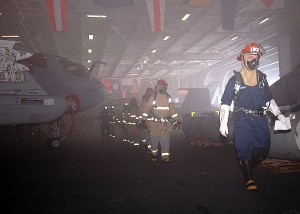 That errant butt sidelined a centerpiece of the Fleet for 3 months. Three months–to give you more perspective, repairs required over 55,000 man-days of work.
That errant butt sidelined a centerpiece of the Fleet for 3 months. Three months–to give you more perspective, repairs required over 55,000 man-days of work.
The illicit smoke break damaged more than just a ship—it was a costly strategic embarrassment for America–and a real distraction as the Navy worked to prepare for future threats in the Pacific.
Remember? In 2008, the USS George Washington was on the way to Japan, where the ship was set to serve as a centerpiece of the Navy’s re-orientation to the Pacific. Instead, America’s fragile dominance went on full display as the Navy scrambled to keep a tired, retirement-bound USS Kitty Hawk (CV-63) on station.
At home, thousands of Navy families watched their intricate relocation plans crumble.
The amount of damage was stunning.
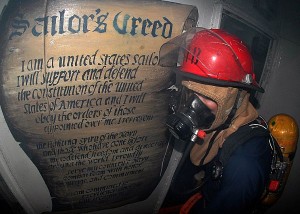 I mean, out of all the infamous “Carrier-Killing” weapons in the world, none—NONE–have done more damage to a nuclear aircraft carrier than a lowly cigarette. And the fact that one carelessly discarded cigarette butt —with the help of poor stowage and damage control—can effectively soft-kill a capital ship should scare everybody.
I mean, out of all the infamous “Carrier-Killing” weapons in the world, none—NONE–have done more damage to a nuclear aircraft carrier than a lowly cigarette. And the fact that one carelessly discarded cigarette butt —with the help of poor stowage and damage control—can effectively soft-kill a capital ship should scare everybody.
The USS George Washington fire demonstrated that modern aircraft carriers are more vulnerable to cigarettes than real bombs and flaming aviation fuel. Though 27 sailors lost their lives in 1969 during the USS Enterprise’s massive ordinance-fed flight-deck fire, the Enterprise was back in service in less than two months.
It’s quiet testimony to the threat posed by fire at sea—and the ever-present vulnerability of complex ships to the unexpected (check out the damage to those cableways!).
 Congressional micromanagement of this issue (dating back to the USS Theodore Roosevelt’s smoke-banning experience back in 1993) is extremely frustrating. If limiting the ability of sailors to purchase cigarette PACKS aboard ship reduces smoking rates and reduces the risk of a fire at sea, then I’m for it.
Congressional micromanagement of this issue (dating back to the USS Theodore Roosevelt’s smoke-banning experience back in 1993) is extremely frustrating. If limiting the ability of sailors to purchase cigarette PACKS aboard ship reduces smoking rates and reduces the risk of a fire at sea, then I’m for it.
In the long run, a smoke-free ship is safer, more ready to put warfighting first, and, finally, a smoke-free crew saves both the Navy and the taxpayer serious money.
Unthinkable!
I know people don’t like the idea of a ban on cigarettes–I have great friends–and great skippers–who smoke like a chimney. I also know that, as of today, today, tobacco is part of Navy culture. Introduced to western navies in the sixteenth century by Sir Walter Raleigh, tobacco is now woven so deeply into Navy life that the idea of a tobacco-free Navy is, in some circles, almost unthinkable.
But, heck, a Navy without sails was, back in the day, unthinkable, too.
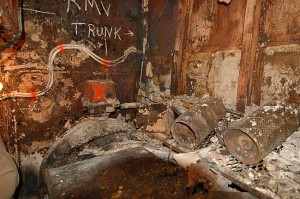 And, for that matter, so was the idea of enjoying a refreshing smoke after a battle. I mean, the Greeks and Persians who fought at Salamis had no post-battle pause that refreshes. Battle-hardened sailors fought at sea long before tobacco was a thing, and were simply darn glad to be alive after.
And, for that matter, so was the idea of enjoying a refreshing smoke after a battle. I mean, the Greeks and Persians who fought at Salamis had no post-battle pause that refreshes. Battle-hardened sailors fought at sea long before tobacco was a thing, and were simply darn glad to be alive after.
A big part of the Navy is already smoke-free. In 2010, the Navy’s seventy-two submarines banned smoking with no measureable reduction in overall effectiveness.
For the surface Navy, smoking is a luxury. I personally suspect that smoking is an increasingly poor fit with the pace of life and modern war at sea. I mean, as crews get smaller and smaller, and the sailors get more and more tasks, what shipmate wants sailors responsible for combat management really, reeeallly neeeeding to sneak off for a smoke in the midst of a long-running engagement? What happens when you’re buttoned up for a Nuclear, Biological or Chemical (NBC) threat? Addicts will need to either sneak a smoke or they will loose their effectiveness as a battle manager.
Warfighting first, right?
Either the Navy steps backward, and really facilitates smoking at sea, or the organization makes an investment in a healthier—and arguably—less costly force. I think the right route is pretty clear. Is there a challenge in managing a smoke-free workforce? As a veteran from the Gulf Coast Shipbuilding community, there’s an ongoing joke that rapid personnel ramp-ups would be impossible if yards banned smoking. But, surprisingly, progressive yards like BAE are going smoke-free. And guess what-they’re having no problems finding workers, and, in time, those savings will hit the bottom line and everybody will benefit (in fact, why not meld non-smoking or health-related initiatives into procurement activities, eh?).
 So….bottom line. Congress needs to stop meddling and quit micromanaging the Navy.
So….bottom line. Congress needs to stop meddling and quit micromanaging the Navy.
It’s the hypocrisy that gets me. To be honest, if China had developed real PACKS—Portable Aircraft Carrier Killer Systems—and had demonstrated the weapon’s prowess by disabling a Carrier, Congress would be demanding the Navy address this threat, ASAP. Smokers wouldn’t get within miles of a CVN. But instead, we have Congressman Duncan Hunter–the Congressman whose district benefited from an unexpected, smoker-caused $70 million-dollar ship repair job–out there carrying the torch for Navy smokers everywhere.
Final analysis–Smoking is a readiness issue, a discipline issue, a unit cohesion issue, a safety issue, fiscal issue and a strategic concern. In the end, the Navy is made up of volunteers–volunteers who can, if they don’t like the rules that organize their Navy life–volunteer elsewhere, at a more gentle and tolerant institution.
Nostalgia Never Dies
 Always eager to recapture the golden past of naval warfare, some out in the fleet still fetishize the days when tobacco was a regular prop for heroism and an indicator of leadership. Island-hopping World War II hero General Douglas MacArthur was rarely pictured without his trusty corncob pipe, and crusty, chain-smoking Fleet Admiral William “Bull” Halsey used his memoirs to claim he never trusted “a fighting man who doesn’t smoke or drink.
Always eager to recapture the golden past of naval warfare, some out in the fleet still fetishize the days when tobacco was a regular prop for heroism and an indicator of leadership. Island-hopping World War II hero General Douglas MacArthur was rarely pictured without his trusty corncob pipe, and crusty, chain-smoking Fleet Admiral William “Bull” Halsey used his memoirs to claim he never trusted “a fighting man who doesn’t smoke or drink.
But two things.
First, humanizing as they might be, at the very least, let us recognize that these oft-aped vices were stage-managed by leaders who actively cultivated a populist image. But stage-managed vices are perilous things, and there is a long, storied list of leaders who let their initially harmless image-enhancing leadership-crutch get the better of ‘em. General Stanley McChrystal’s fondness for Bud Lite Lime may have helped build a more cohesive command cadre, but it also helped him towards an untimely dismissal. And, well, Poker is great fun with the boys until you start encountering forged chips. Same for drinking. For every good “bad” boy, there are a heck of a lot who just…break bad.
The second thing to consider the fact that Admiral Bull Halsey never lost a capital asset to a sailor’s errant cigarette butt. If he had, I expect he’d have been the first to demand real action to ensure that sailors under his command would never, ever be tempted into irresponsible smoking ever again.
Conclusion:
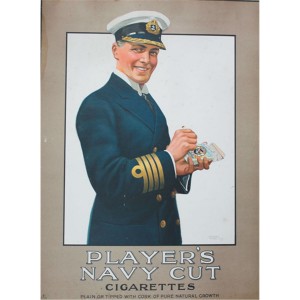 If a sailor wants to smoke, fine. But the Navy has no business subsidizing the habit, nor in supporting the habit when it endangers fellow shipmates. I am all for a responsible Navy–an occasional cigar, cigarette or beer is relatively harmless–but there is no need to sell tobacco aboard ship or ashore. And if the Navy bans beer and wine, it can darn well ban cigarettes.
If a sailor wants to smoke, fine. But the Navy has no business subsidizing the habit, nor in supporting the habit when it endangers fellow shipmates. I am all for a responsible Navy–an occasional cigar, cigarette or beer is relatively harmless–but there is no need to sell tobacco aboard ship or ashore. And if the Navy bans beer and wine, it can darn well ban cigarettes.
Frankly, I’d urge the Navy make the “assessment of tobacco use” a wider alcohol and tobacco assessment, and leak the idea that, in exchange for limits on tobacco use, alcohol and wine might be permitted at certain on-ship activities. That–at least–would get the Navy out of big tobacco’s direct line of fire by pitting two big interest groups against each other. But, alas, I’m not the SECNAV.
But back to tobacco. No matter how we try to spin it, fire at sea is dangerous, and the more opportunities smokers have to get addicted in the service–and then feel entitled to smoke when they shouldn’t and where they shouldn’t–it becomes a real threat to the force. Exhibit “A” is the USS George Washington.
The Navy knows America cannot afford to loose a CVN to some PACKS-welding addict. And so does Congress. So get out of the way! It’s time for Congress to stop micromanaging the Navy and let the service attend to the business of creating the future force.
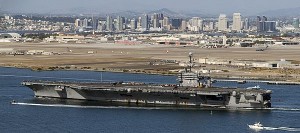

{ 9 comments… read them below or add one }
> Studies show…more than 60 percent of Marines had
> used some form of tobacco in the previous 12 months.
> Marines may be more invested in this issue than the
> average Line sailor.
I think of four reasons making that figure so much higher than expected. First, 60% is more of an ‘experimentation’ figure (past 12 months) than routine daily use. Second, chewing tobacco is a popular smokeless vice in the Marines, but not the Navy because… Third, chewing tobacco spittoons (spit pots) are highly incompatible with rocking ships and narrow passageways, while Marines spend 98% of their careers on terra firma which they consider one big spittoon (and toilet).
Fourth and lastly, just plain immaturity of 18-20 year-old Marines, of which most are simply experimenting with different personalities and peer pressures. They’re experiencing life outside their parents home for the first time. It’s said the richest man in the world is a PFC with a paycheck on a Friday night. Those were the days. I’ve seen young incoming Marines go from western wear to disco wear to biker leather in the span of a year, all without coming near a horse, disco floor or motorcycle. Tobacco use is consistent with the youthful pursuit of machismo, which itself is consistent with most young lads signing up for the Marines. I was the nerdy/athletic exception, of course.
We are looking at 20% (M) and 16%(F) trending downward in society.
http://www.abs.gov.au/ausstats/abs@.nsf/Lookup/4125.0main+features3320Jan%202013
The figures are higher in uniform but still trending downward. Part of this may be closer scrutiny and the influence of shaping questions to capture ‘social’ smokers who might otherwise not be included in surveys of the wider population.
http://amma.asn.au/amma2012/wp-content/uploads/2012/10/Miranda-van-Hooff2.pdf
Data on deployed personnel was significantly higher, also we do not have the same tradition of using smokeless tobacco products which might also influence figures.
Latest data from Stripes might be useful in informing discussion:
Studies show military members use tobacco at higher rates than same-age civilians. A 2011 Defense Department survey showed 24 percent of troops smoked, compared with 20 percent of civilians of the same age. It also showed that more than 60 percent of Marines had used some form of tobacco in the previous 12 months.
Marines may be more invested in this issue than the average Line sailor.
I agree that we shouldn’t facilitate or subsidise what is acknowledged as an unhealthy and addictive practice. The stats for smoking among serving personnel are dropping generally in line with the rest of the population. In my experience the participation rate in ‘beer issue’ has also fallen significantly.
The sense of entitlement does not just apply to smoking, it is far more prevalent. It applies to internet access and the use of social media, and also use of weights rooms and gymnasiums. I am sure there are many more areas. The problems come when the individuals do not conform to the rules that are there to protect them and others.
Yes, numbers 1, 2, and 3, on my list above are all good things…FOR THE SMOKERS.
Commitment to a healthy lifestyle shouldn’t bar a sailor from similar opportunities.
Craig – numbers 1, 2, and 3 on your list above are all good things.
Chris–
I’m not for banning, but I’m sure not for subsidizing (or otherwise facilitating) that habit. If “warfighting first” is the tenet, then we need to look at smoking through that lense–if smokers put their addiction before their job, or, conversely, banning creates more of a distraction from the job at hand (searching for smuggled cigars, say), then we’re not doing the Navy any favors. There’s a middle ground somewhere here–just as there should be with, say, limited access to beer or wine on ship…
That said, I agree with Mark, though….smoking (and the habits associated with subsidizing it) are too often seen as an entitled right. And as a habit transforms to an addiction, it’s becoming far too easy these days for a smoker to justify unauthorized smoke breaks in improper places. Smoking is a luxury and should be treated as such.
For recruits, the habit too-easily correlates with 1) frequent breaks from work (twice-daily 15 min smoke breaks inevitably grow), 2) membership in a select and welcoming “frat”/social community, often with 3) unmatched opportunities for access or to mix with superiors/seniors as equals.
I remember observing the ritual of smoke breaks in the well decks of LSTs (Newport class). It was considered a necessary distraction such that a smoker looked busy while the non-smoker next to them looked idle – what a slacker. A non-smoker taking a fresh air break aboard ship was often barked back to work, and then the supervisor ‘bums a smoke’ from the breaking smokers. It was a culture that fostered bad habits and hazards.
Sorry Craig, I can’t support your (albeit tongue in cheek) premise that the cigarette was the principal issue in the case above. It is as logically flawed as arguing that the fire wouldn’t have started if the offending individual had using intravenous drugs rather than tobacco, therefore we should permit sailors to shoot up onboard.
The cause, as is nearly always the case was a confluence of a break down in a number of safety processes; Smoking in an unauthorised space, and inappropriate storage of flammable materials.
I personally haven’t smoked in over 20 years, and we no longer have excise free tobacco products on our ships, but I do not think that prohibition of a legal substance will result in a safer workplace at sea. If anything it will result in more smoking occurring in unauthorised and unsafe areas. I am happy to leave the grand political gestures to the politicians, let the sailors get on with driving their ships.